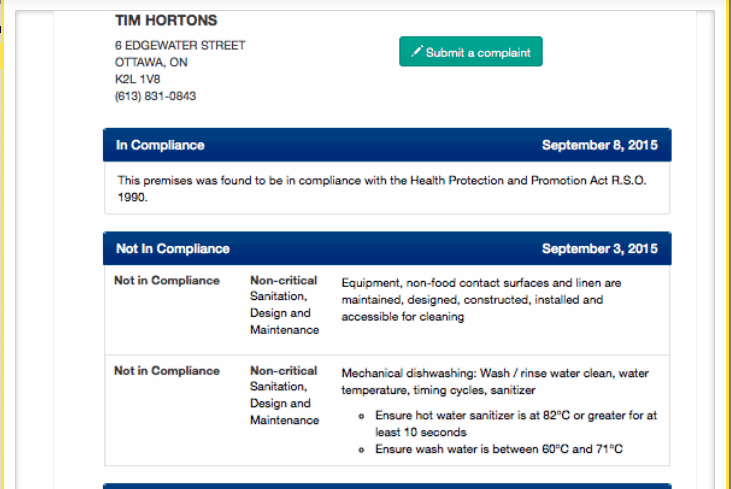By Nicole Rutherford
Ottawa Tim Hortons food inspection infractions dropped by over 1,000 failures since 2009.
Each time a food inspector goes into a restaurant, he or she can fail the restaurant in several different categories; from poorly-sanitized surfaces to noting incorrect food temperatures.
For Tim Hortons, both the number of inspections and category failures have decreased significantly since 2009.
That year, inspectors gave Ottawa Tim Hortons restaurants 1,301 category failures. In 2015 they received 260. That’s what you call a double-double decrease.

This can largely be attributed to a change of policy in Ottawa Provincial Health’s (OPH) inspection tools. These outlines were once individual to the city, but in 2014 the City of Ottawa changed their policies to one that is consistent throughout Ontario.
“Internally we were more stringent,” said Franco Pagani, a supervisor in OPH’s Environmental Health Protection Branch. “It was more subjective to the health unit going in. Now there’s one consistent tool used throughout the province.”
Pagani insists, however, that there is no loss of safety when it comes to the declining numbers.
“It is still safe, but now we are on par with the rest of the province,” Pagani said. “We are still meeting our accountability agreements. We still go in regularly and if there are complaints we go in.”
He also noted that if a restaurant consistently performed well, it would typically see fewer inspections in the coming years.
One example of this is the Tim Hortons at number six Edgewater Street, which had had the highest number of food inspection infractions for Ottawa Tim Hortons since 2009—504 in total. However, for 2014 and 2015 the restaurant passed beautifully, with only two infractions in total.

When asked if it was the change in policy that had affected her restaurant, Edgewater Tim Hortons Assistant Manager Renee Pelletier was adamant.
“I can say with great confidence that we have not seen one single change,” Pelletier said. “We even have the same inspection guy come in.”
She noted that the inspector might come in less often, but she attributed this to a change in management, internal training and company policy.
“We are doing a lot more in-depth training and cross-training—that is, taking people who work at the storefront and training them in the back so they better understand how the business runs,” Pelletier said.
Additionally, the company has upgraded its tracking system to a digital version, switching from paper notes to iPad logging systems.
Maintenance logs, equipment logs, bathroom checks, manager walk-throughs and eye-flush and sanitization stations have alarms that go off and are noted digitally.
“It’s better than having people stare at a piece of paper,” Pelletier said. “At first it is pretty in-depth, but soon you start to notice a big difference.”
Despite this clock-work accuracy, Pagani noted that at the end of the day, all Tim Hortons restaurants are considered low-risk restaurants for food inspection—that is they are less likely to have problems that would make people ill.
Inspectors assess the restaurants and the minimum number of visits they require per year based on their risk level: high risk restaurants such as a full-menu restaurant that serve raw food, such as a sushi restaurant, would require a minimum of three visits per year. Medium risk requires two, and low risk, one.
This would also explain Pelletier’s elusive inspector.
“Bottom line, we are meeting the accountability agreement with the restaurants that need inspecting,” Said Pagani. “Now we have a consistency with all other cities and health units in Ontario.”
In either case, it looks like your Canadian coffee experience is still safe.

